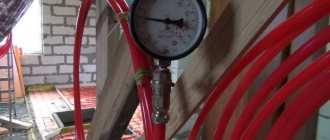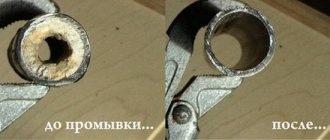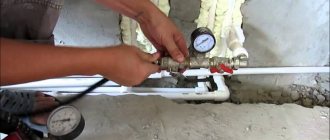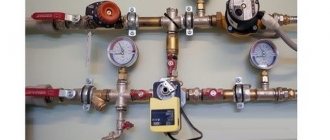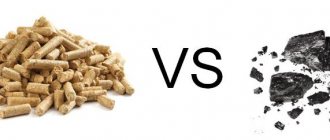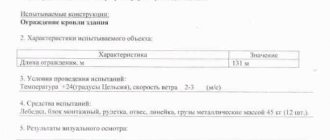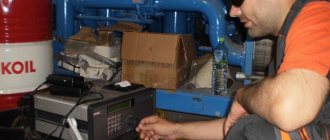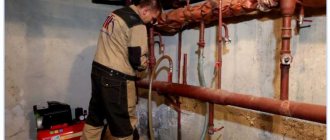Document year: 2019
Document group: Acts
Type of document: Act
Download formats: DOC, PDF
Test reports are drawn up in the form of document forms in which the results of testing the performance of mechanisms and equipment are recorded.
In today's article, we will consider in detail the testing of pipeline systems, sewerage systems, stairs and stepladders, roof fencing and fire tests.
Examples of drafting acts can be downloaded for free at the end of the article.
Hydraulic testing report for the heating and water supply pipeline system
Checks of heating and plumbing systems are carried out:
- when introducing new engineering communications;
- when reconstructing an existing one;
- during a routine check of the functioning of the system.
The step-by-step inspection and its results are recorded in the test report. The system is tested for tightness and strength in two ways, one of which is the hydraulic method: testing by using water with increased load. This method is suitable for indoor and outdoor systems (at temperatures not lower than +5C). The second method is pneumatic.
Both methods of acceptance testing are called pipe testing.
The results of the inspections are recorded in a report, the form of which is established by the Code of Rules for building codes and regulations. The template is presented in Appendix 1 to SANPin “External networks and structures of water supply and sewerage.” The presented form of the act is mandatory.
Procedure for drawing up the act:
1. Indication of general organizational information: city of compilation and date.
2. Representation of the members of the commission that carried out the pressure testing and acceptance of the pressure pipeline. Three parties become members:
| The company that installed the pipeline |
| Technical supervision representative from the customer |
| Operating company representative |
3. Below is information about the inspected object and a description of the pipeline (length, diameter, material of pipes and joints), information specified in the working documentation is given, and information about the pressure gauge used is given.
4. The section about the test and its results is completed.
5. In the section “Decision of the commission” there is a statement that the system is considered strong and airtight and this is signed by the members of the commission.
You can download the form for free at the end of the article.
Pipe crimping
As you can easily guess from the title of the article, its topic will be pipe crimping - what crimping is, why it is done and what tools are needed for it.
Crimping: a concept in a broad sense
The very concept of “pressure testing” in relation to metal-plastic hoses should be considered in the broad sense of the word. For example, pressure testing often refers to standard tests carried out hydraulically or pneumatically.
But modern practice shows that the term “pressure testing” also quite logically fits the procedure for connecting a fitting and a metal-plastic pipe. This type of connection is made using power crimping technology using a special tool (press pliers).
The photo shows the moment of crimping during the process of joining metal-plastic pipes. In this case, crimping is a mechanical force action aimed at achieving tightness of a reliable connection
Regardless of the installation conditions and the technologies used, the installation of water supply or other communications based on metal-plastic pipes is accompanied by tests for tightness and strength.
This is approximately what the connection point for a pressure testing pump to a water supply system on metal-plastic pipes looks like. One of two control pressure gauges is installed at the inlet, which determines the tightness of the circuit
Typically, the testing process is carried out hydraulically. But the possibility of testing using the pneumatic method is not excluded.
Conclusion
: Pressure testing of the heating main - let's look at the main thing
Introduction. up
The purpose of this article is to describe the procedures for pressure testing (pressure testing) of installed pipes and connections of the heating and water supply system to check the quality of the work performed.
The general principles of the hydrostatic (water pressure testing) and manometric (air pressure testing) methods are described.
Specific recommendations from leading manufacturers of polymer pipelines, which are often used in the installation of heating and water supply in private homes, are considered: Uponor, Rehau, Herz, Kan. Sets out local codes and regulations regarding pressure testing.
What is pressure testing of pipelines and connections. up
After installing pipelines and connections of elements of heating and water supply systems, it is necessary to check the quality of installation work and make sure there is no damage or poorly installed elements.
Such tests must be carried out before and immediately during the embedding of elements of engineering systems into the building structures (pouring floor screeds, plastering grooves, sewing niches, etc.).
This procedure allows you to promptly notice and eliminate accidental damage, reducing the likelihood of the so-called manifestation. "human factor".
A self-tapping screw accidentally screwed into a pipe laid in the wall or a sharp nail on a shoe when pouring heated floor pipes, or a pipe damaged during transportation or installation can (and often does) go unnoticed if pressure testing has not been carried out. During commissioning, these damages still make themselves felt and require expensive repairs, incl.
and to restore the fine finishing of the premises (replacing tiles, plastering, puttying, painting, wallpapering, etc.).
Pressure testing of pipes can be carried out either with water (the working medium - which is preferable) or, in some cases, with air. Checking pipelines with air is most often carried out when the ambient temperature drops below +5°C and there is a risk of water pipes freezing.
The methods for testing heating and water supply systems with water (hydrostatic tests) and air (manometric tests) are somewhat different (see below).
The test pressure should be selected based on the test medium (water or air), the operating pressure of the piping system, the pipe manufacturer's recommendations, and local codes.
Conclusion
I think we have fully answered the question of what pipe crimping is and why it is needed. The choice of a specific tool is up to you. Good luck!
Certificate of pneumatic testing of pipelines
Pneumatic method: diagnosis by pumping the system with high pressure air. Often the method is used for external systems if the temperature on the thermometer is less than +5 Celsius.
The procedure for crimping pipes by pneumatic testing is given in the same SanPiN; the test report is drawn up in the required form, which is given in Appendix No. 3.
Requirements for drawing up test documentation:
- Filling in the name of the city and the date of compilation.
- Indication of the members of the commission (as in the hydraulic test, three parties are involved).
- Description of the pipeline: length, diameter, material of pipes and joints.
- Information about the pressure value: calculated value, to what value the pressure in the pipes was increased, final pressure, amount of reduction. The crimping time is indicated.
- In the “Decision of the Commission” section, each of its members signs with a transcript if the pipeline has passed pneumatic diagnostics and is sealed and durable.
Work procedure
It is recommended to study this procedure in order to exercise control over the company’s employees performing this procedure.
First, preparatory work must be carried out; with a newly installed system, this means preliminary flushing and visual inspection for leaks. In the old scheme, it would not hurt to drain all the coolant, clean the mud trap and perform a thorough flush. The boiler should be isolated from the system using taps. For the crimping operation, an electric or manual pump equipped with a pressure gauge is required. The test can be done by pumping water (hydraulic method) or air (pneumatic method) to the required pressure. With the pneumatic method, the pump is simply connected to the system’s feed fitting and pumping begins. The hydraulic method requires filling the system with water and carefully bleeding air from it, otherwise you may get an incorrect result.
Important. A factory pump for testing a heating system is often equipped with a pressure gauge designed for a maximum pressure of 50 Bar and it is not easy to determine a value from it, for example, 9 Bar
In such situations, you must have an additional device with a scale of no more than 16 bar, mounted in the form of a unit with taps and connected to the pump, as shown in the photo:
Air pressure testing of heating is done with a conventional automobile pump, connected to the replenishment or emptying pipe through a unit with a pressure gauge, shown in the photo. It is enough to pump up a pressure of 2 bar; this is enough to check the tightness with air. Then you need to keep the pipelines under pressure for several hours, while it is better to turn off the drain valve, recording the readings of the device.
Over time, the pressure in the system may drop by 0.2-0.3 Bar, after which the pressure gauge needle will stop. This is due to the heating and expansion of air during pumping and is considered an acceptable error.
As for hydraulic testing, the pressure testing rules (VSN 69–97) require first bringing the pressure to the worker and inspecting for leaks or ruptures. Then, over the course of half an hour, the pressure is gradually increased twice by one and a half times - to the test pressure. That is, with a system pressure of 2 Bar, you need to pressurize at 3 Bar. If the drop does not exceed 0.6 Bar, then it is necessary to maintain a period of time of at least 2 hours. Is the pressure gauge needle still in place? The test has been successfully completed and you can begin filling out the form.
In a situation where the pressure gauge shows a continuous slow drop in pressure in the network, you need to look for a leak. This is done visually or using a soap emulsion and a brush. Once a leak is detected, the leak is eliminated and the heating pipes are pressure tested again.
Certificate of testing of external and internal sewerage for spillage
A test report for internal and external sewerage is drawn up as a result of checking the operability of the system. It confirms the position of the commission that the system has withstood the test of a spill of water, and the design complies with the design documentation, GOSTs and standards.
Diagnostics of the normal functionality of the sewer system is necessary when installing a new facility or after carrying out repair work on an existing system. Information about the performance check is entered into the report. The form is drawn up in the form specified in Appendix “D” to the Code of Rules 73.13330.2012.
The act specifies:
- name of the system and the facility in which it is installed;
- information about the members of the commission. Representatives of three organizations are needed: the general contractor, the customer and the installation company;
- information about the name of the project is written down;
- the results are entered: the number of simultaneously connected devices, as well as the connection time or filling of water on the floor (unnecessary ones are crossed out);
- the third paragraph states that no leaks were detected at the joints and through the walls. This means the system is suitable for use.
The decision is signed by the members of the commission.
In what cases is it compiled?
The act is required when:
- Commissioning of new equipment. The certificate will confirm that each element is in its place, the installation was carried out responsibly, and the system is working.
- The heating season is approaching. After a summer break in work, the pipes could fail. After checking their capacity, a report is drawn up.
- Already carried out repair work.
- The occurrence of contained emergency situations on the pipeline. In this way, specialists identify the amount of work required and the weak points of the existing heating network.
For the uninterrupted operation of the heating system, preventative control checks and reliable information about the quality functioning of the system upon startup are necessary.
Fire test reports
During testing for the performance and safe operation of fire equipment, several reports are drawn up:
- checking fire hydrants;
- diagnostics of internal water supply;
- checking for the safety of use and compliance with labor protection rules of fire escapes.
Fire hydrants
Testing the performance of hydrants for water loss is carried out twice a year and is often combined with checking the fire-fighting water supply system. Based on the results of the inspection, an act is drawn up and signed by the commission. Mandatory members: a representative of the fire inspection and a representative from the organization in which the inspection is taking place. Also, the commission may consist entirely of company employees.
The act states:
- general organizational information (information about the company, date and place of compilation);
- the main part describes the members of the commission and the progress of the test. Information about hydrants is presented in tabular form. The location address, diameter, pressure, water yield and affiliation of the hydrant are indicated;
- in the final part, compliance (or non-compliance) with the requirements of the hydrant condition is established.
At the end, the act is signed by authorized members of the commission.
Internal fire water supply
The act establishes the presence or absence of defects and malfunctions in the fire water supply system. The inspection is carried out by responsible employees of the enterprise. Frequency – at least twice a year; for flammable industries, inspections may be scheduled more often.
Internal fire water supply (IFP) is a complex system of pipes, sensors, and switches. Therefore, it is often checked by a labor protection or fire safety specialist, as well as by persons who are trained in fire safety.
The act is drawn up on letterhead or plain paper indicating the details. Be sure to register:
- information about the organization and participants of the inspection;
- information about the object being checked;
- inspection results;
- recommendations for eliminating defects and malfunctions, if any are found;
- signatures of responsible persons.
If additional documents are attached to the act, their list and name are indicated.
Fire escapes
Testing of firefighting equipment, including ladders and stepladders, is regulated by a special GOST. Inspections can be carried out by organizations that have received permission from the Ministry of Emergency Situations and have special equipment for this.
The test results are recorded in the test report. The documentation provides standard information about the organization and its details, information about the members of the commission. The main part provides information about the inspected objects (number of ladders and stepladders, their inventory numbers and affiliation with the structural unit), information about the results of inspections (absence or presence of defects). An instruction is given to eliminate the identified faults.
At the end, the act is signed by the members of the commission.
GENERAL PROVISIONS
1. GENERAL PROVISIONS
1.1. Installation of internal sanitary systems should be carried out in accordance with the requirements of these rules, SN 478-80, as well as SNiP 3.01.01-85, SNiP III-4-80, SNiP III-3-81, standards, technical specifications and plant instructions — equipment manufacturers.
When installing and manufacturing components and parts of heating systems and pipelines to ventilation units (hereinafter referred to as “heat supply”) with water temperatures above 388 K (115 ° C) and steam with a working pressure of more than 0.07 MPa (0.7 kgf/sq. cm) you should also follow the Rules for the Construction and Safe Operation of Steam and Hot Water Pipelines, approved by the USSR State Technical Supervision Authority.
1.2. Installation of internal sanitary systems and boiler rooms must be carried out using industrial methods from pipeline units, air ducts and equipment supplied complete in large blocks.
When installing coatings on industrial buildings from large blocks, ventilation and other sanitary systems should be installed in the blocks before installing them in the design position.
Installation of sanitary systems should be carried out when the object (occupancy) is ready for construction in the amount of:
for industrial buildings - the entire building with a volume of up to 5000 cubic meters and part of the building with a volume of over 5000 cubic meters, which, based on location, includes a separate production room, workshop, bay, etc. or a complex of devices (including internal drains, heating point, ventilation system, one or more air conditioners, etc.);
for residential and public buildings up to five floors - a separate building, one or several sections; over five floors - 5 floors of one or more sections.
1.3. Before installation of internal sanitary systems begins, the general contractor must complete the following work:
installation of interfloor ceilings, walls and partitions on which sanitary equipment will be installed;
construction of foundations or sites for the installation of boilers, water heaters, pumps, fans, air conditioners, smoke exhausters, air heaters and other sanitary equipment;
construction of building structures for ventilation chambers of supply systems;
installation of waterproofing in places where air conditioners, supply ventilation chambers, and wet filters are installed;
construction of trenches for sewerage outlets to the first wells and wells with trays from the building, as well as laying inputs for external communications of sanitary systems into the building;
installation of floors (or appropriate preparation) in places where heating devices are installed on stands and fans installed on spring vibration isolators, as well as “floating” bases for installing ventilation equipment;
arrangement of supports for installing roof fans, exhaust shafts and deflectors on building surfaces, as well as supports for pipelines laid in underground channels and technical undergrounds;
preparation of holes, grooves, niches and nests in foundations, walls, partitions, floors and coatings necessary for laying pipelines and air ducts;
drawing on the internal and external walls of all rooms auxiliary marks equal to the design marks of the finished floor plus 500 mm;
installation of window frames, and in residential and public buildings - window sill boards;
plastering (or cladding) the surfaces of walls and niches in places where sanitary and heating appliances are installed, pipelines and air ducts are laid, as well as plastering the surface of grooves for hidden installation of pipelines in external walls;
preparation of installation openings in walls and ceilings for the supply of large equipment and air ducts;
installation in accordance with the working documentation of embedded parts in building structures for fastening equipment, air ducts and pipelines;
Roof fencing test report
Technical requirements and roof testing methods are enshrined in the same GOST as the standard for fire escapes and stepladders (53254-2009).
Tests are carried out at intervals of five years, integrity checks are carried out every year. The results are documented in acts.
The conditionally completed act can be divided into three parts:
- General information. Information about the tested object and the inspecting organization is entered here.
- Information about the inspection (what manipulations were carried out, what tools were used).
- Test results (compliance with GOSTs, integrity and safety of the structure).
The agreement of the commission members during testing is confirmed by their personal signatures.
Organizations with a license from the Ministry of Emergency Situations have the right to conduct inspections and tests. Defects found must be corrected.
Conclusion
Hydraulic tests differ greatly between central and autonomous heating systems. If in the latter case they can be carried out independently, in the former this should only be done by specialists. The quality of the measures taken will determine the operation of heating the building in cold weather.
The video in the article will provide an opportunity to find additional information on the above topic.
Did you like the article? Subscribe to our Yandex.Zen channel
Test report for ladders, racks and stepladders
Inspection and testing of racks, ladders and stepladders is carried out at least once every six or twelve months (depending on the object being tested and the material from which it is made).
Tests and checks for safe operation can be carried out by specialized organizations from outside or a commission specially created at the enterprise. At the same time, its members must be trained; an occupational safety or fire safety engineer is usually appointed as the chairman of the commission.
As a result of the diagnosis, the commission draws up a report; it is better to document it with the date of the inspection. The header indicates the name of the document, date and place of compilation. It is also important to indicate the details of the organization, list the members of the commission: their positions and full names.
In the main part, describe the tests of stepladders, ladders and racks:
- how many were checked, their inventory numbers, belonging to the workshop and department;
- what load was used and for how long;
- presence and absence of defects;
- availability of an assigned inventory number.
As a result of the test, suitability (or unsuitability) for use is established: they are safe, can withstand the required load, do not have defects in connections and fastenings, do not have sharp edges or burrs.
The signing of the act by the commission members indicates agreement with the results of the inspection.
By the way! If after this article you still have questions about how to fill out the forms, contact the site’s on-duty lawyer.
Delivery of documents
Here
After completion of the work, a pressure testing certificate is drawn up, which has legal force.
This kind of document will confirm that:
- the heating system was checked for leaks in accordance with all standards;
- all equipment is in good condition and therefore ready for use;
- if after the issuance of such a document accidents occur, then all responsibility will fall on those who carried out the inspection.
Those responsible for carrying out this procedure, as well as its results, can be appointed:
- Representatives of the organization that provides heat supply (this is a foreman, inspector, or even an engineer and technician). They must have with them all the relevant documents, equipment, as well as forms of issued acts.
- Representatives of the facility itself where the pressure testing was carried out. Thus, in apartment buildings these are employees of management organizations, in private houses - their owners, and if the procedure is carried out in administrative or social facilities - these can be managers, as well as employees of supervisory organizations.
- In cases where pressure testing was done in a new building that is just being put into operation, representatives of the contractor should be added to the commission.
The water supply system is also checked in the same way. When all the taps in it are closed, increase the pressure to the required level and look for holes. All commercial properties are inspected exclusively on a paid basis, due to which the cost of work is always included in the estimate. Therefore, you need to find out in advance how much such a procedure will cost.
Watch the video in which a specialist explains in detail what pressure testing of a heating system is, why it is performed and where it is carried out:

